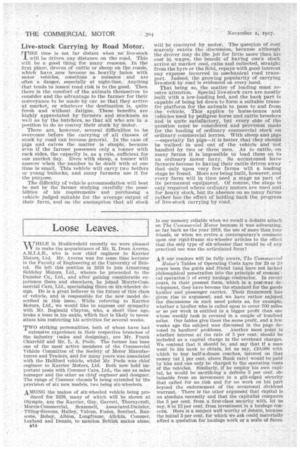Live-stock Carrying. by Road Motor.
Page 32

If you've noticed an error in this article please click here to report it so we can fix it.
HE time is not. far distant when no live-stock I_ will be driven any distance on the road. This will be a good thing for many reasons. In the first place, droves of cattle or sheep on the roads, which have now become so heavily laden with motor vehicles, constitute a nuisance and are often a danger, .especially at night-time. Anything
• that tends to lessen road risk is to the good. Then there is the comfort of the animals themselves to consider and the advantage to the farmer for their conveyance to be made by car so that they arrive at market, or whatever the destination is, quite fresh and without fatigue. These benefits are highly appreciated by farmers and stockmen as well as by the butchers, so that all who are in a position to do so convey their stock by motor.
There are, however, several difficulties to be
overcome before the carrying of all classes of stock by road Can become general. In the case of pigs and calves the • matter • is simple, because even if the -farmer possesses only a tonner with rack .sides, the capacity is, as a rule, sufficient, for one market day. Even with sheep, a tonner will answer when the number to be dealt with at one time is sMall.This vehicle Will carry two heifers or young -bullocks, and Many farmers use it for the purpose.
The difficulty of vehicle accommodation will best be:met by the farmer studying carefully the possibilities of his requirements and purchasing vehicle judged suitable for the average output of their .farm, and on the assumption that all stock will be conveyed by motor. The question of .cost scarcely enters the discussion, because although the drover may do the job for little more -than his cost in wages, the benefit of having one's stock arrive at Market cool, .calm and Collected, straight from the byre or the field, repays with good interest any expense incurred in mechanical road transport. Indeed; the growing popularity of carrying live-stock by road is evidenced, on every hand.
That being so, the matter of loading must receive attention. Special live-stock cars are, mostly built with a low-loading bed, and the back part is capable .of being let clown to form a suitable transfer platform for the animals to pass to and from the vehicle. This applies to horse-boxes and vehicles used by pedigree horse and cattle breeders and is quite satisfactory, but every side of the question must be considered and provision made for the loading of ordinary commercial stock on ordinary Commercial lorries. With sheep and pigs —especially fat .pigs—it is better, that they should be Walked in and out of the vehicle and not handled by two or three men. As to cattle, on many farms it is 'impossible to lead them on to an ordinary Motor lorry. So accustomed have farmers become to having their cattle driven away that only upon very few farms will a loading stage be found. More are being built, however, and every farm will in time need a stage as part of its permanent equipment Of course, the stage is only required where ordinary motors are used and for heavy stock, but its absence on so many farms rather has the effect of holding back the progress of live-stock carrying by road.




































































































